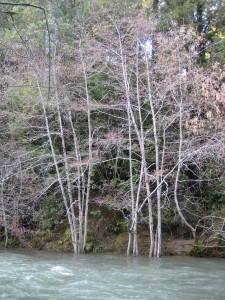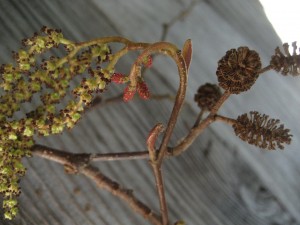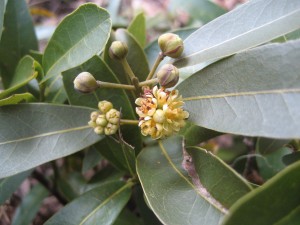Winter Bloomers
 Even though it is still winter, some plants are starting to bloom.
Alders are one of the first plants to bloom in winter. These trees usually start blooming in December, but some early bloomers start in November. You can see the orange-brown catkins hanging down from bare branches, a beautiful sight all winter long. The catkins are the male flowering structure, and release pollen to fertilize the female cones. The cones persist on the trees and in the fall, the winged seeds are dispersed. The alder that grows in our area is the red alder, Alnus rubra, and has red inner bark and roots. Growing along streams, seeps, and springs, this fast growing tree needs
Even though it is still winter, some plants are starting to bloom.
Alders are one of the first plants to bloom in winter. These trees usually start blooming in December, but some early bloomers start in November. You can see the orange-brown catkins hanging down from bare branches, a beautiful sight all winter long. The catkins are the male flowering structure, and release pollen to fertilize the female cones. The cones persist on the trees and in the fall, the winged seeds are dispersed. The alder that grows in our area is the red alder, Alnus rubra, and has red inner bark and roots. Growing along streams, seeps, and springs, this fast growing tree needs plenty of water. You can see the red roots growing right out into the water in streams. Alder groves are a stunning sight, with their pale, almost white trunks mottled with black, growing tall up to their interlocking crowns. Red alders are in the family Betulaceae, along with birch and hazelnut. Since alder roots produce nitrogen, they are a pioneer species, that is, one of the first plants to come into an area after fire, flood, clearcut or other major disturbance. On disturbed sites, they can grow away from water and are short-lived, as they enrich the soil, making way for other species to move in and crowd them out.
plenty of water. You can see the red roots growing right out into the water in streams. Alder groves are a stunning sight, with their pale, almost white trunks mottled with black, growing tall up to their interlocking crowns. Red alders are in the family Betulaceae, along with birch and hazelnut. Since alder roots produce nitrogen, they are a pioneer species, that is, one of the first plants to come into an area after fire, flood, clearcut or other major disturbance. On disturbed sites, they can grow away from water and are short-lived, as they enrich the soil, making way for other species to move in and crowd them out.
 Bay trees are another winter bloomer. Starting around the new year, the small creamy yellow flowers start to open. Flowers are in umbels, or umberella shaped clusters. Standing under a blooming bay tree on a sunny winter day is a sensory experience: they give off a heavenly floral scent and are noisily abuzz with pollinating insects. Once the flowers are pollinated, fruits resembling small, round avocados form. By summer, the fruit’s skin has fallen away, leaving a nut, or bayberry. On years with abundant bayberry crops, walking under a bay tree can give you a slippery ride, with your feet rolling out from under you. The California bay tree, also called pepperwood, myrtle, or laurel, is Umbellularia californica. It is in the family Lauraceae, and is related to the European bay laurel, avocado, camphor and cinnamon. Bay leaves contain many active compounds and have many uses. They can be used for seasoning foods, chewed on to relieve toothache, steeped in a hot bath to relieve arthritis pain, and can be crushed to release the aromatic oils which help relieve headaches and cleanse wounds.
Written by Cheryl Lisin
]]>
Bay trees are another winter bloomer. Starting around the new year, the small creamy yellow flowers start to open. Flowers are in umbels, or umberella shaped clusters. Standing under a blooming bay tree on a sunny winter day is a sensory experience: they give off a heavenly floral scent and are noisily abuzz with pollinating insects. Once the flowers are pollinated, fruits resembling small, round avocados form. By summer, the fruit’s skin has fallen away, leaving a nut, or bayberry. On years with abundant bayberry crops, walking under a bay tree can give you a slippery ride, with your feet rolling out from under you. The California bay tree, also called pepperwood, myrtle, or laurel, is Umbellularia californica. It is in the family Lauraceae, and is related to the European bay laurel, avocado, camphor and cinnamon. Bay leaves contain many active compounds and have many uses. They can be used for seasoning foods, chewed on to relieve toothache, steeped in a hot bath to relieve arthritis pain, and can be crushed to release the aromatic oils which help relieve headaches and cleanse wounds.
Written by Cheryl Lisin
]]>
